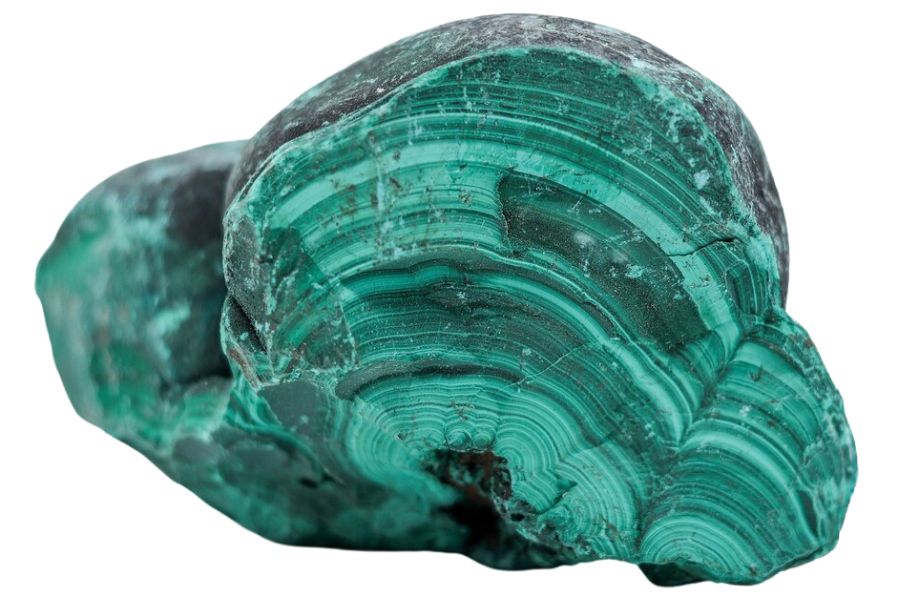Rocks, minerals, gems, and crystals that are green in color have long been sought after for their beauty, rarity, and healing properties. From malachite to jade to emeralds, green gems are some of the most prized possessions in the world.
Green rocks can be found in many forms, from raw stones to polished gems. Many of these stones are formed from the same elements as other minerals but may contain higher levels of certain trace elements that give them their unique hue.
Green rocks, minerals, gems, and crystals are often associated with abundance, growth, and fertility. Whether you’re looking for a unique piece of jewelry or an addition to your collection, these green rocks are a great choice!
Green Gems and Crystals
The following are some of the world’s most stunning and alluring green gems and crystals:
Alexandrite – BeAl2O4
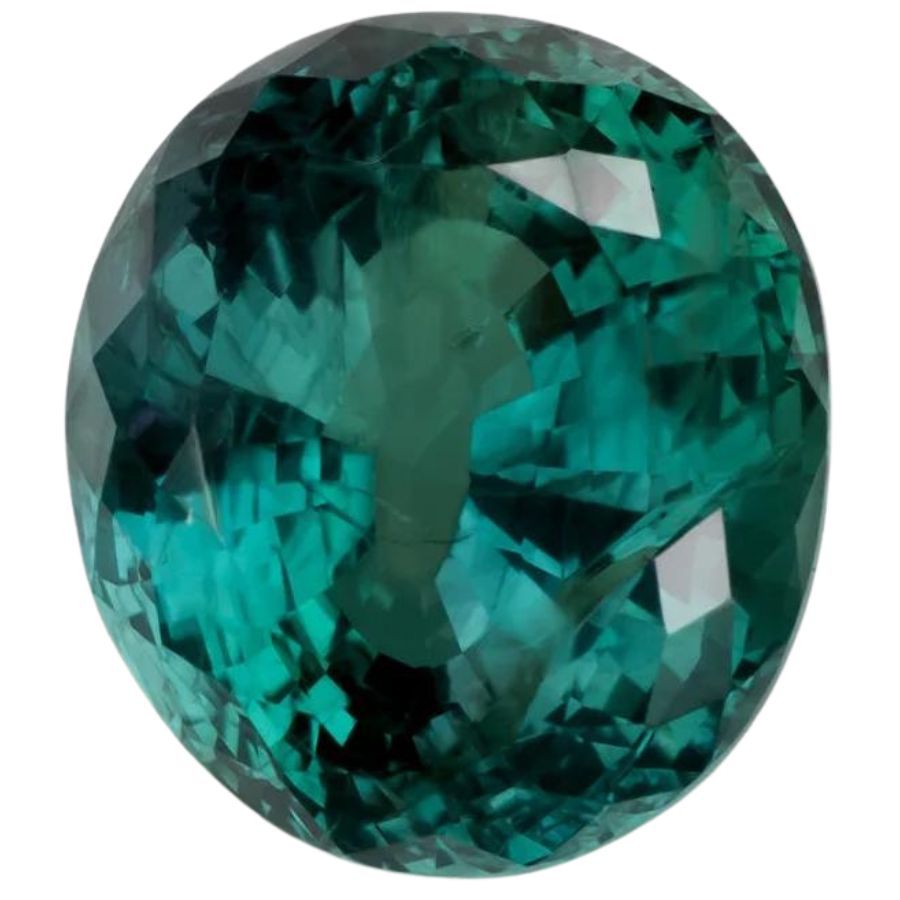
Alexandrite is a unique gemstone known for its color-changing ability, shifting from green in daylight to red under incandescent light. This feature makes it popular in jewelry, where its dynamic colors can be showcased.
Besides jewelry, alexandrite is also used in scientific instruments due to its optical properties. Its rarity and distinct color change have made it a valuable and sought-after stone. Collectors and gem enthusiasts often prize alexandrite for its uniqueness and beauty.
The gem’s ability to change color is not just attractive but also fascinating to observe in different lighting conditions.
Fun Fact
Did you know? Alexandrite is a rare type of gemstone that changes color depending on the lighting; it appears green in natural light and red in artificial light. Amazing, right?Where alexandrite is found
Alexandrite can be found worldwide, including Sri Lanka, India, Brazil, Madagascar, Tanzania, and Russia.
How you can identify alexandrite
Color
Alexandrite is a gemstone known for its rare color-changing ability. It typically appears as a green-blue hue in natural daylight and shifts to a purplish red in incandescent light.
Hardness
Alexandrite is typically rated 7.5 to 8 on the Mohs scale of mineral hardness. This puts it in the range of quartz and topaz, meaning it’s considered to be quite hard and durable.
Clarity
Alexandrite’s clarity can vary, but high-quality stones are often very clear with few inclusions, making them especially prized.
The clearer the stone, the more pronounced its remarkable color change effect, enhancing its overall appeal and value.
Refractive index
The refractive index of an alexandrite ranges from 1.746 to 1.754, with an average of 1.750. Alexandrite is a rare gemstone that exhibits a strong color change from green to red depending on the type of light it’s exposed to.
Specific gravity
The specific gravity of alexandrite ranges from 3.62 to 3.65, which is similar to that of quartz and corundum.
Demantoid Garnet – Ca3Fe3+2(SiO4)3
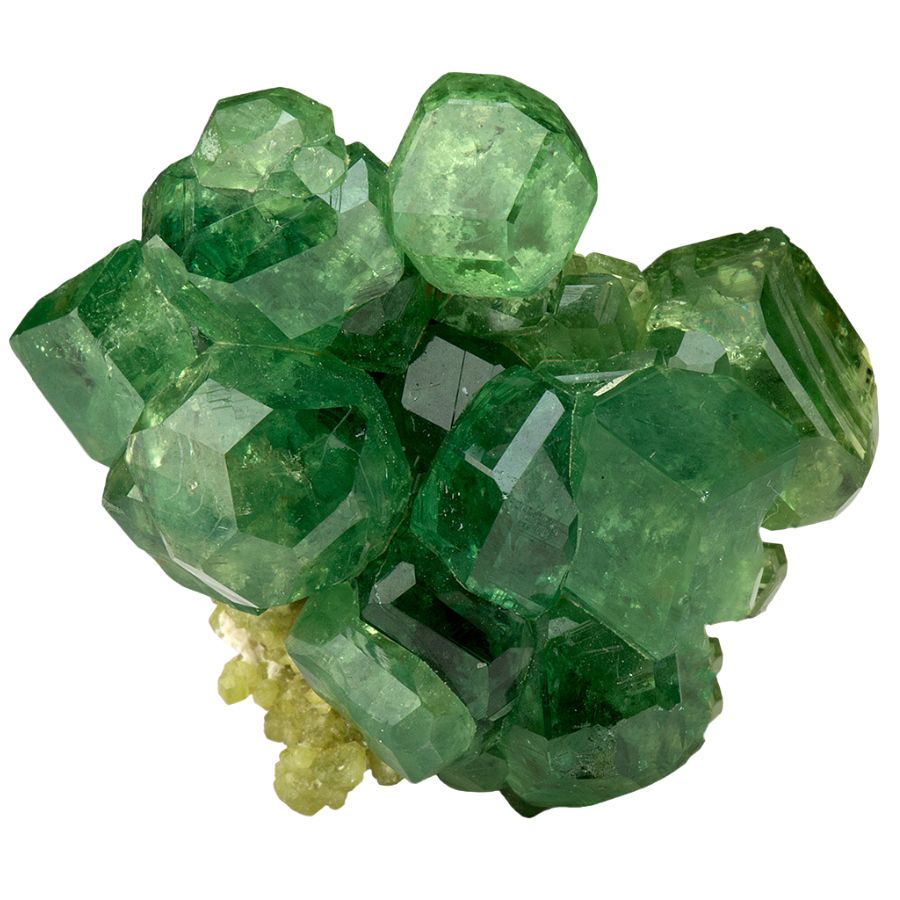
Demantoid garnet is a bright green gemstone known for its sparkling fire and brilliance. It’s most commonly used in jewelry, such as rings, necklaces, and earrings, where it adds a vibrant touch.
Its unique green color makes it a favorite among collectors and those seeking a distinctive piece. Demantoid garnet is also used in various artistic settings, adding flair to decorative items and accessories.
The stone’s radiant green hue has inspired designers to create pieces that stand out for their beauty and color. Although it’s softer than some other gemstones, with proper care, demantoid garnet jewelry can last and be enjoyed for many years.
Fun Fact Demantoids are well-liked by collectors and auction houses all over the world. They were a favorite of the renowned Russian jeweler Carl Faberge, who is well known for his Faberge eggs, which were requested by Tsar Alexander III of Russia.
Where demantoid garnet is found
Demantoid garnet is primarily found in Russia’s Ural Mountains, which is renowned for producing some of the finest quality stones with the most intense green colors.
Other notable sources include Namibia, Iran, and Italy, where smaller deposits have been discovered, contributing to the gem’s global availability.
How you can identify demantoid garnet
Color
Demantoid is a vibrant and eye-catching shade of green. It has a light yellowish-green hue, often with hints of yellow or brown, and is known for its strong dispersion of light, giving it a sparkling effect.
This rare gemstone usually has an olive tint with subtle hints of gold or yellow.
Hardness
It has a hardness rating on the Mohs scale of 6.5 to 7.5, making it quite hard and suitable for jewelry and other decorative applications.
The strong dispersion of light and fire in demantoid makes it an incredibly desirable gemstone, and its durability ensures it will last for many years with proper care.
Clarity
Demantoid garnet often contains unique, horsetail-like inclusions, which can be considered desirable and are sometimes used to identify the gem.
While high-quality demantoid garnets are typically clear and free of any cloudiness, many stones will have some inclusions, which do not necessarily detract from their beauty or value.
Refractive index
The refractive index of demantoids is typically between 1.888 to 1.893, which is higher than the refractive index of most other gemstones.
It has a high dispersion (0.050) and double refraction, making it excellent for producing flashes of rainbow colors in the right light.
Its birefringence (0.005) is also relatively high compared to other gems, allowing it to create an attractive ‘fire’ effect when cut into a cabochon or faceted into a brilliant cut.
Specific gravity
The specific gravity of demantoids is 3.2 to 3.5, which is higher than most other gemstones. This high specific gravity allows it to have greater brilliance and fire than other gems, making it a highly sought-after gemstone for jewelry and collectors.
Demantoid also has an exceptionally high refractive index, giving it a unique sparkle that is not found in any other gemstone.
Dioptase – CuSiO3 · H2O
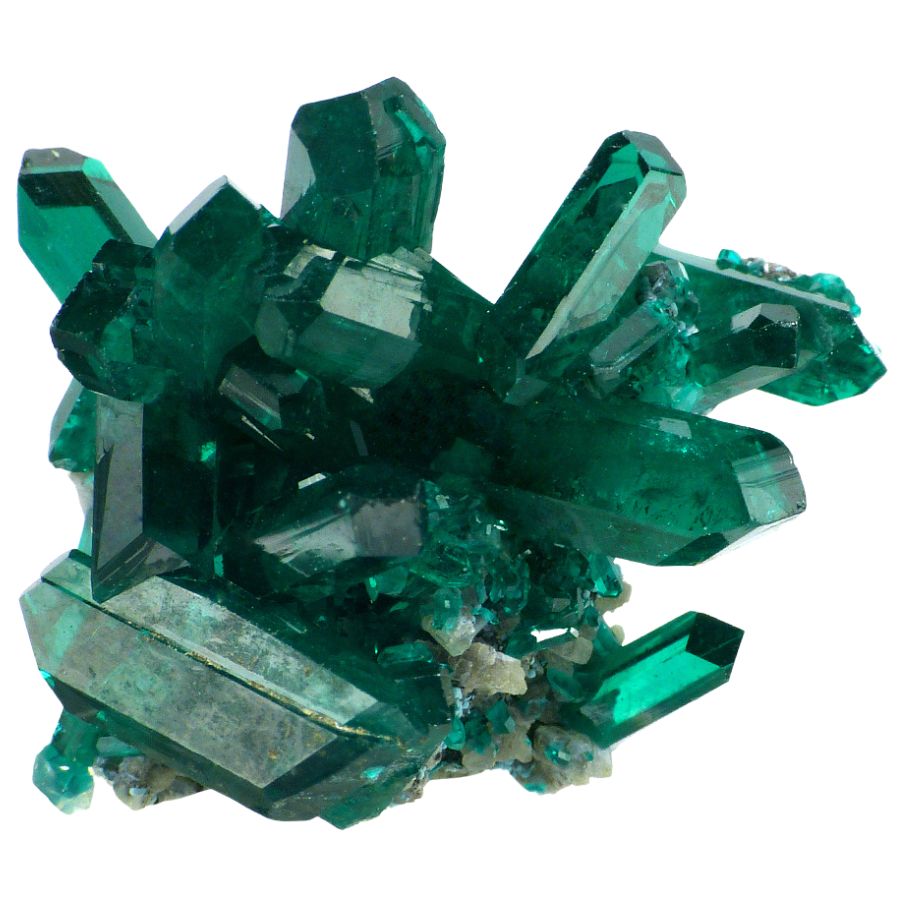
Dioptase is a vibrant green gemstone known for its striking color and glassy luster. It’s often used in jewelry as a unique and eye-catching gem, especially for those who love the color green.
Dioptase can also be found in mineral collections, where its bright color and crystal forms are admired. In the world of art, its intense green hue inspires artists and decorators looking for natural, earthy tones.
While it’s a softer gemstone, careful handling and setting can make it a beautiful choice for special occasion wear. Collectors and gem enthusiasts prize dioptase for its color and rarity, making it a special addition to any collection.
Fun Fact
Dioptase and the human tooth enamel both have a hardness of 5. But do not test it at home because the mineral will definitely win!Where dioptase is found
Dioptase is a relatively rare mineral found in Namibia, Angola, Zimbabwe, Kazakhstan, Romania, Argentina, Chile, the Congo Republic, the Democratic Republic of the Congo, and many other mines or locales. It’s typically found with oxidized copper deposits.
How you can identify dioptase
Color
Dioptase is a deep emerald green, with a hint of blue. It has a bright, almost glowing quality that draws the eye in. Its hue is unique and captivating, and its gemstone clarity is unparalleled.
The color of dioptase seems to shift slightly depending on the lighting, making it even more intriguing.
Hardness
Dioptase is a very hard mineral on the Mohs scale, rating at 6 on the scale. Its hardness is comparable to that of quartz, and it can scratch glass, but it’s not as hard as topaz or diamond.
Clarity
Dioptase typically exhibits a translucent to transparent clarity, allowing light to pass through and enhancing its rich green color.
However, it often contains natural inclusions or may be slightly cloudy, which is common in this type of mineral but doesn’t significantly detract from its visual appeal.
Refractive index
Dioptase has a refractive index of 1.721, which is relatively high compared to other minerals. Its birefringence is 0.008, and its dispersion is 0.037, which are fairly low values.
It exhibits a slight pleochroism in transmitted light, appearing blue-green or yellow-green depending on the angle of observation.
Specific gravity
Dioptase is a mineral composed of hydrated copper silicate and has a specific gravity of 3.25-3.6, which is considered to be relatively high compared to other minerals.
This high specific gravity means that dioptase has a greater mass per unit volume than other minerals, making it heavier than most.
Emerald – Be3Al2(Si6O18)
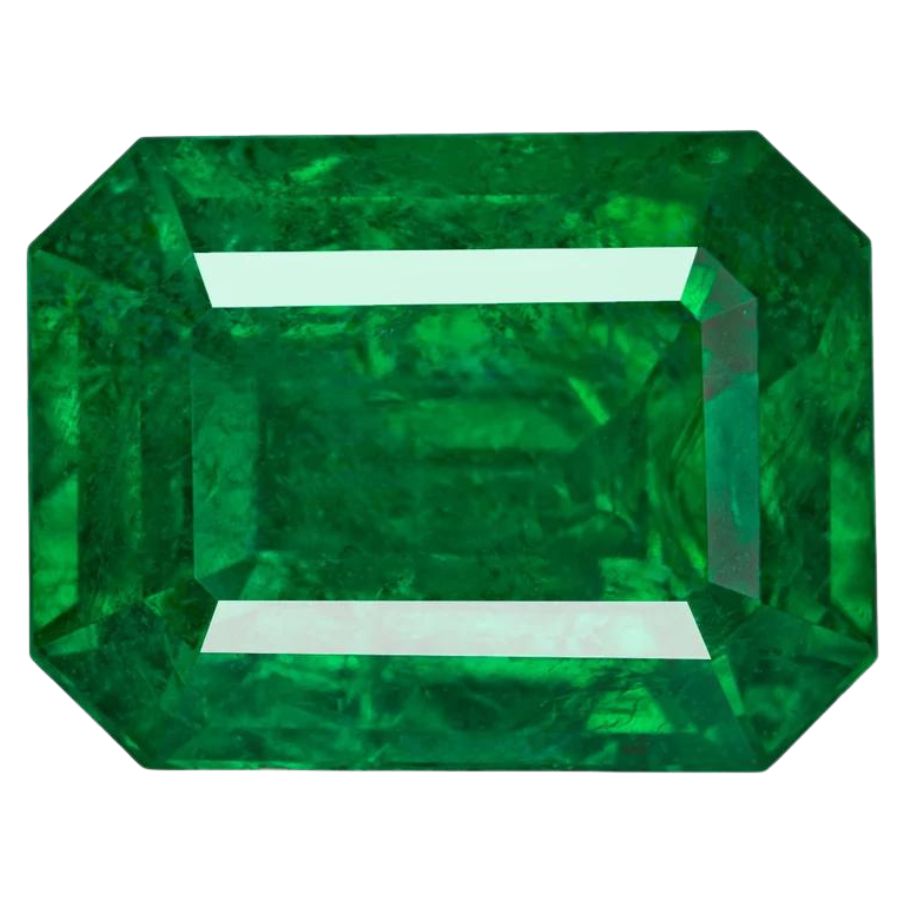
Emerald is a beautiful and precious gemstone, prized for its stunning green color. It’s among the most valuable and sought-after gems in the world.
Emeralds have been treasured since ancient times, with some of the oldest known specimens dating back to around 330 BC. The Ancient Egyptians were said to have mined emeralds in the eastern desert and the famous Cleopatra’s Mines.
The Incas also treasured the stone and believed it to have healing properties.
Emeralds are often cut into various shapes and sizes to maximize their beautiful green color. They are used to create exquisite jewelry pieces such as rings, earrings, necklaces, and bracelets.
Fun Fact One of the largest uncut emeralds is still the Duke of Devonshire emerald. It's currently kept in "The Vault" in London's History Museum.
Where emeralds are found
The primary emerald deposits are found in Zambia, Colombia, and Brazil. Emeralds are mined in Pakistan, Afghanistan, Russia, Australia, and the United States as well.
Unsure if what you’ve stumbled upon is emerald or something else? Don’t fret! Our user-friendly guides are designed to assist you in distinguishing emeralds from other rocks and minerals.
How you can identify emeralds
Color
Emerald is a brilliant, deep green color that evokes the lushness of nature. It’s a vibrant hue that speaks to its namesake gemstone and has a lush, velvety feel.
The color has hints of blue, making it appear almost aquatic in certain lights. It’s an elegant color that can bring a touch of sophistication to any room or wardrobe.
Hardness
Emerald has a hardness rating of 7.5 to 8 on the Mohs scale. It’s harder than quartz and glass but softer than topaz and diamond. Emerald is the third hardest gemstone in the beryl family, behind aquamarine and morganite.
Its hardness makes it a durable stone for jewelry, although it can still be scratched or chipped if not cared for properly.
Clarity
Emeralds are known for their “jardin,” or internal garden of inclusions, which is considered part of their natural beauty and uniqueness.
While high-quality emeralds can possess a high degree of transparency, most natural emeralds contain inclusions that can affect their clarity, yet they are still highly valued and cherished for their rich color and overall appearance.
Refractive index
Emerald is a type of beryl with a refractive index of 1.577 to 1.583, slightly higher than other gemstones’ average refractive index.
This indicates that emerald has a more remarkable ability to bend light, making them appear more brilliant and vibrant when compared to other gems.
Specific gravity
The specific gravity of emerald is 2.72 to 2.78, which is considered relatively high for a gemstone. This means that emerald is denser than most other gemstones, which have a greater weight for their size than other gems.
This higher density also contributes to the emerald’s durability and makes them more resistant to scratches and chips.
Jadeite – Na(Al,Fe3+)Si2O6
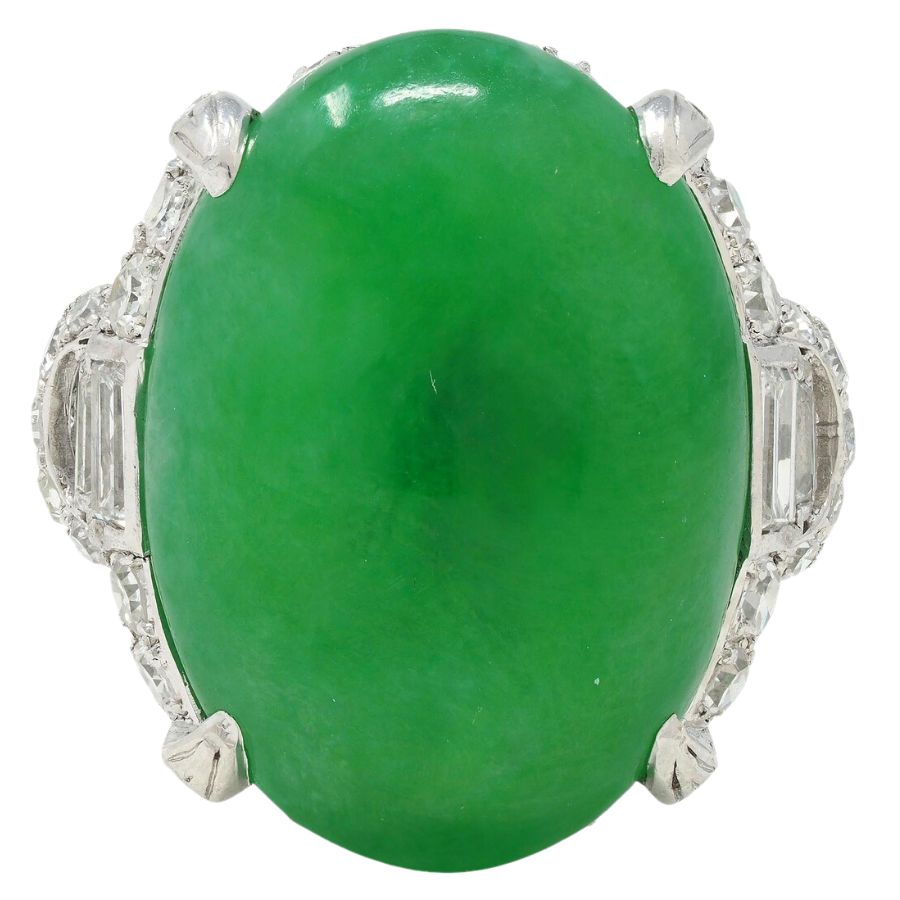
Jadeite is a highly prized gemstone that comes in a variety of beautiful colors, with green being the most famous. It’s often carved into intricate shapes and used in jewelry like bangles, earrings, and pendants, adding a touch of elegance and color.
Due to its toughness, it’s also shaped into tools and decorative objects that are both beautiful and durable. Historically, it has been used in art and as part of cultural artifacts, valued for its smooth finish and rich hues.
People love jadeite for its sleek and cool feel, which makes it a pleasure to handle and wear. Its popularity continues today, with many appreciating jadeite for its beauty and the skill required to carve this tough gemstone into delicate designs.
Fun Fact
Axe heads, knives, and other weapons were made out of jadeite during the Stone Age in many different cultures. Where jadeite is found
Small quantities of jadeite can be discovered in Guatemala, while most of it is currently mined in Myanmar. Canada, Australia, the United States, and Taiwan are among the countries where Jadeite is mined.
Mistaking jade for other rocks and minerals is common, but we’re here to help. Look at our informative guides below to ensure that what you have is indeed jade:
How you can identify jadeite
Color
Jadeite is a highly sought-after gemstone that can range in color from white to light green, dark green, lavender, pink, yellow, orange, and brown.
Hardness
Jadeite is a tough stone with a Mohs hardness rating of 6.5 to 7. It’s considered one of the toughest and most durable gemstones, making it an ideal choice for jewelry and carvings.
Clarity
Jadeite’s clarity can range from completely opaque to semi-transparent, with the most valuable pieces often being slightly translucent.
While some jadeite may have a smooth, even texture, other pieces can show variations in color and minor inclusions, which do not necessarily detract from the stone’s overall value or appeal.
Refractive index
Jadeite has a refractive index of 1.66 to 1.67, making it the second-highest of all transparent gemstones, behind sphene. It has a birefringence of 0.008 and dispersion of 0.013 which gives it an adamantine luster and high brilliance.
Specific gravity
Jadeite has a specific gravity of 3.3 to 3.6, meaning it’s denser than quartz and other similar minerals. This high density makes jadeite very heavy for its size, and it can be used to distinguish it from other minerals easily.
Its specific gravity also gives jadeite a unique tactile feel and makes it highly resistant to scratching and chipping.
Peridot – Mg2SiO4
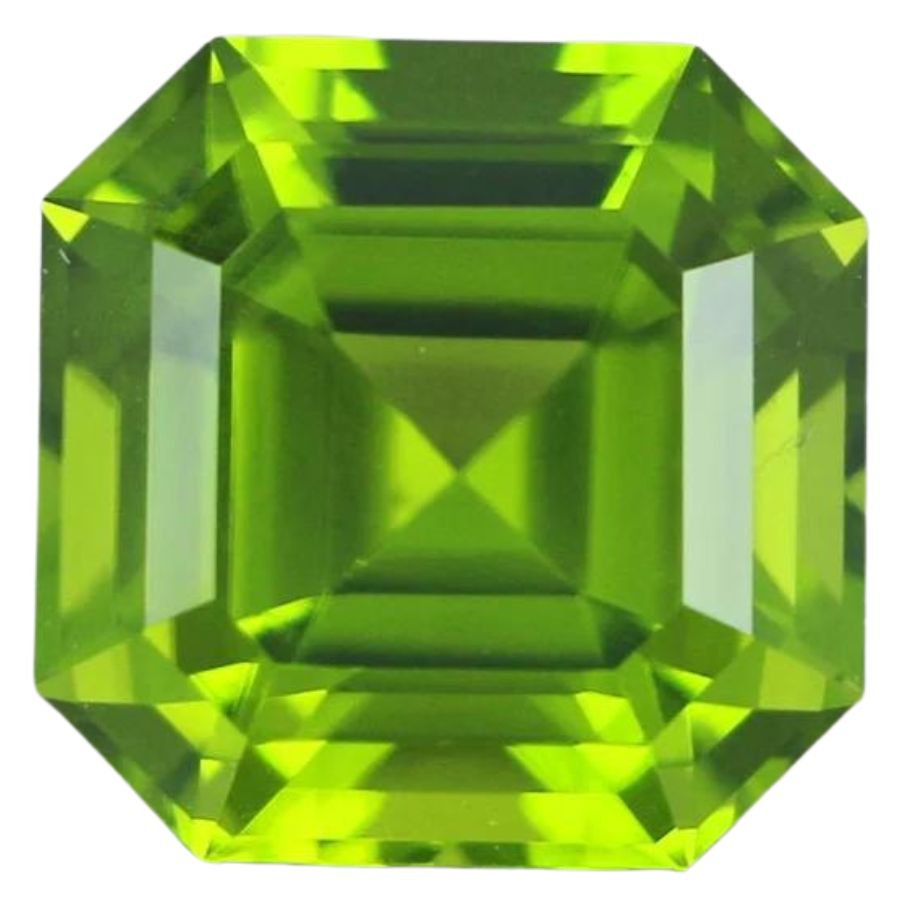
Peridot is a gemstone with a vibrant lime green color that really stands out. People love to use it in jewelry like rings, necklaces, and bracelets because it adds a bright pop of color.
This gem is especially popular for those born in August as it’s their birthstone. Besides jewelry, peridot is sometimes used in beads or small sculptures, showing off its unique green shade.
The stone has a glossy shine that catches the light, making it a favorite for adding a lively touch to various accessories.
Even though peridot is beautiful, it’s also tough enough for everyday wear, making it a practical choice for adding a bit of sparkle to daily life.
Fun Fact Europeans used exquisite Peridot stones to embellish cathedrals during the Middle Ages.
Where peridot is found
Peridots can be found in many locations, including Arizona, Hawaii, Norway, Pakistan, China, and Burma. They can also be found in meteorites and some volcanic rocks.
How you can identify peridot
Color
Peridot is a vibrant, light green gemstone with a yellowish-green hue. It often contains hints of brown or olive and has a glassy, almost translucent appearance.
The peridot’s color is associated with springtime’s natural beauty and can range from bright lime to an olive-like shade, making it an attractive choice for jewelry.
Hardness
Peridot is an interesting gemstone, with a hardness rating of 6.5 to 7 on the Mohs scale. This makes it relatively hard and durable, but not as hard as some other gemstones like diamond or sapphire.
It’s quite resistant to scratching and chipping, so it’s suitable for everyday wear without fear of damage. However, it’s still relatively soft compared to other gems and should still be stored carefully away from objects that may scratch or chip it.
Clarity
Peridot is typically known for its good clarity, with many stones appearing clear and with few visible inclusions to the naked eye.
This clarity allows peridot’s vibrant green color to shine through brightly, making it a sought-after gemstone for those who value purity and luster.
Refractive index
Peridot has a refractive index of 1.655 to 1.689, which is higher than quartz but lower than diamond. Its birefringence is low, ranging from 0.006 to 0.009, and its dispersion is moderate at 0.019. It has a high luster and strong double refraction.
Specific gravity
Peridot has a specific gravity of 3.3 to 3.4, higher than most other gemstones, making it quite dense. This means that it’s heavier compared to its volume compared to other similar gemstones.
Tsavorite Garnet – Ca3Al2(SiO4)3
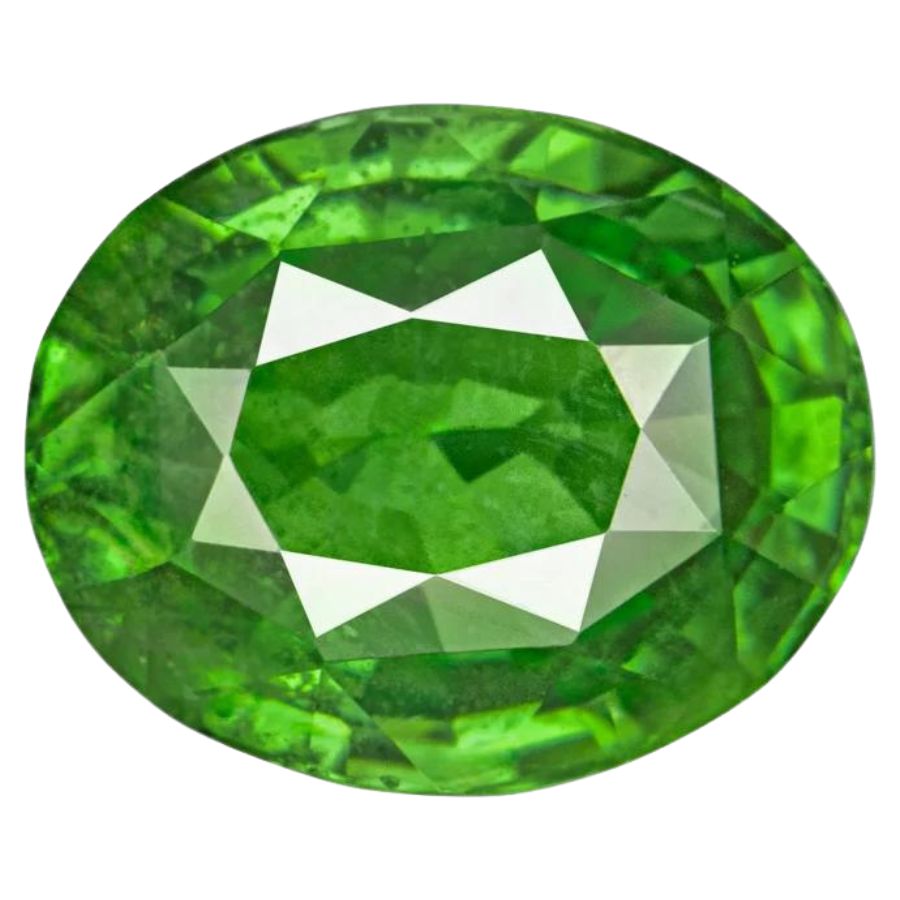
Tsavorite garnet is a gemstone loved for its bright green color, which ranges from a fresh spring green to a deep forest hue. It’s a popular choice in jewelry like rings, pendants, and earrings, where it brings a splash of color and elegance.
Tsavorite is valued for its brilliance and color, often set in pieces that aim to make a statement. It’s also a favorite among collectors who appreciate its rarity and vibrant color. While it’s a durable stone, it’s still cared for gently to keep its sparkle.
Fun Fact
A massive 325.13 carats tsavorite garnet was exhibited at the Tucson Gem Show in 2007. It is still considered as the biggest and clearest tsavorite garnet in existence. This enormous uncut stone weighed 185 grams in its raw state! Where tsavorite garnet is found
Tsavorite garnets are mainly found in East Africa, Kenya, and Tanzania. They are also found in Madagascar, other parts of southern Africa, and Sri Lanka.
How you can identify tsavorite garnet
Color
Tsavorite garnet is an intense, vibrant green gemstone. It has an emerald-like hue, and its color varies from light to dark green depending on the angle of the light.
Hardness
Tsavorite garnet is a relatively hard gemstone, with a rating of 6.5 to 7.5 on the Mohs scale of hardness. It’s durable enough for everyday wear and has good resistance to scratches and abrasions.
Clarity
Tsavorite garnet is a gemstone known for its clarity and brilliance. It has excellent transparency, allowing light to easily pass through and show off the gem’s beautiful color.
Refractive index
Tsavorite garnet has a refractive index of 1.735 to 1.753, which is higher than most other garnets and makes it particularly brilliant and sparkly.
Its high refractive index means it can bend and disperse light into its component colors more effectively, creating a dazzling display of color when the gemstone is viewed from different angles.
Specific gravity
The specific gravity of the tsavorite garnet ranges from 3.64 to 3.68, slightly higher than the average for other garnets. The high density of tsavorite garnet is due to its high iron content, making it heavier than other gemstones of the same size.
Maw sit sit – Multiple minerals
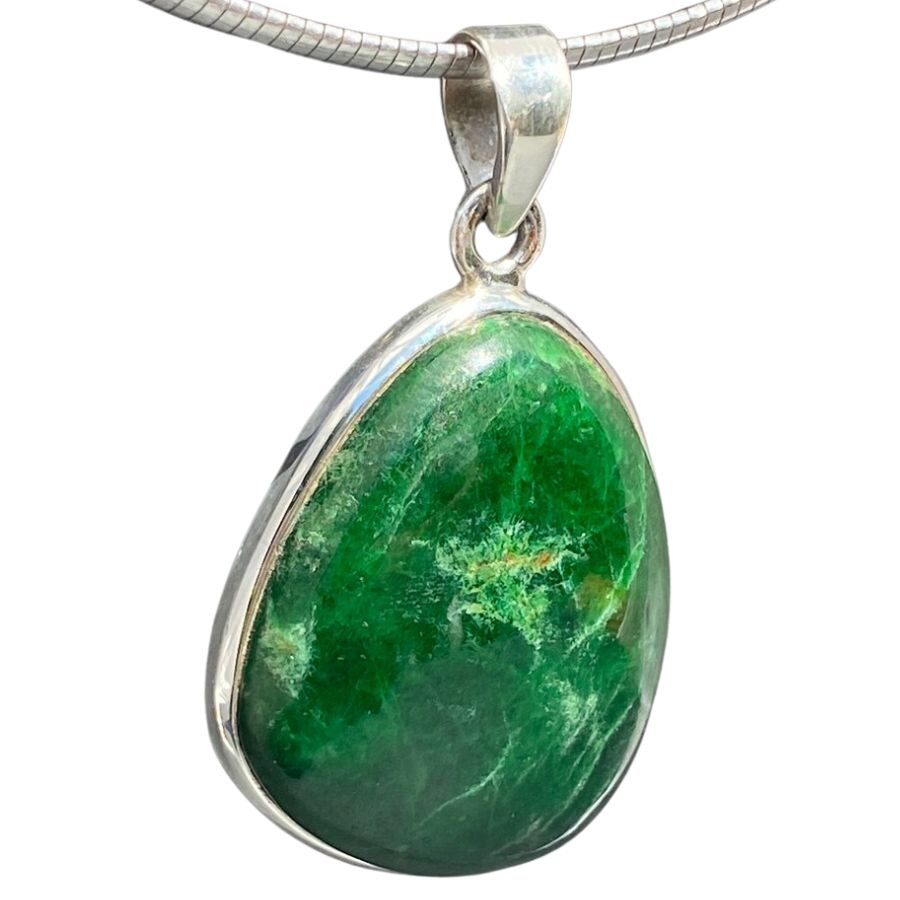
Maw sit sit is a unique and colorful gemstone, known for its vivid green and black patterns. It’s a bit of a mystery stone, as it was only identified in the 1960s, but it has quickly become popular in jewelry, especially as statement pieces.
Its interesting mix of colors and patterns makes each piece of maw sit sit one-of-a-kind. Craftsmen also use maw sit sit for decorative objects, inlay work, or small sculptures, appreciating its intense color and the smooth finish it can achieve.
While it’s not as widely known as some gemstones, those who discover maw sit sit often fall in love with its distinctive beauty. Its durability makes it suitable for various types of wear and use, adding to its appeal as a gemstone.
Fun Fact Maw sit sit is actually named after the village where it was first discovered in Myanmar, making its name as unique as the stone itself. It's composed of several minerals, including jadeite and chromite, which give it the vibrant green color and intriguing patterns that make it so desirable.
Where maw sit sit is found
Maw sit sit is predominantly found in the northern parts of Myanmar, specifically in the Kachin State, where the only known deposits of this intriguing gemstone exist.
How you can identify maw sit sit
Color
Maw sit sit is known for its striking emerald green color, interspersed with dark green to black veins or spots, creating a distinctive and attractive pattern.
The intense green is typically attributed to the high chromium content in the jadeite component of the stone, giving it a vibrant and lush appearance.
Hardness
Maw sit sit has a hardness that can vary due to its composition but typically ranges around 6 to 7 on the Mohs scale, similar to that of jadeite, one of its main components.
This makes it relatively durable and suitable for various types of jewelry and decorative objects, able to withstand wear while retaining its beauty.
Clarity
Maw sit sit generally exhibits an opaque clarity with a dense, smooth texture, contributing to its rich and deep color presentation.
Refractive index
The refractive index of maw sit sit varies due to its composite nature, primarily influenced by its jadeite content, typically ranging around 1.66 to 1.67.
This contributes to the stone’s subtle sheen and the way it interacts with light, enhancing its overall appearance and color depth.
Specific gravity
The specific gravity of maw sit sit typically ranges between 2.5 and 3.5, reflecting its varied mineral composition.
Green Rocks
Here is a list of a few of the most incredible green rocks ever discovered:
Fuchsite – K(Al, Cr)₂(OH)₂
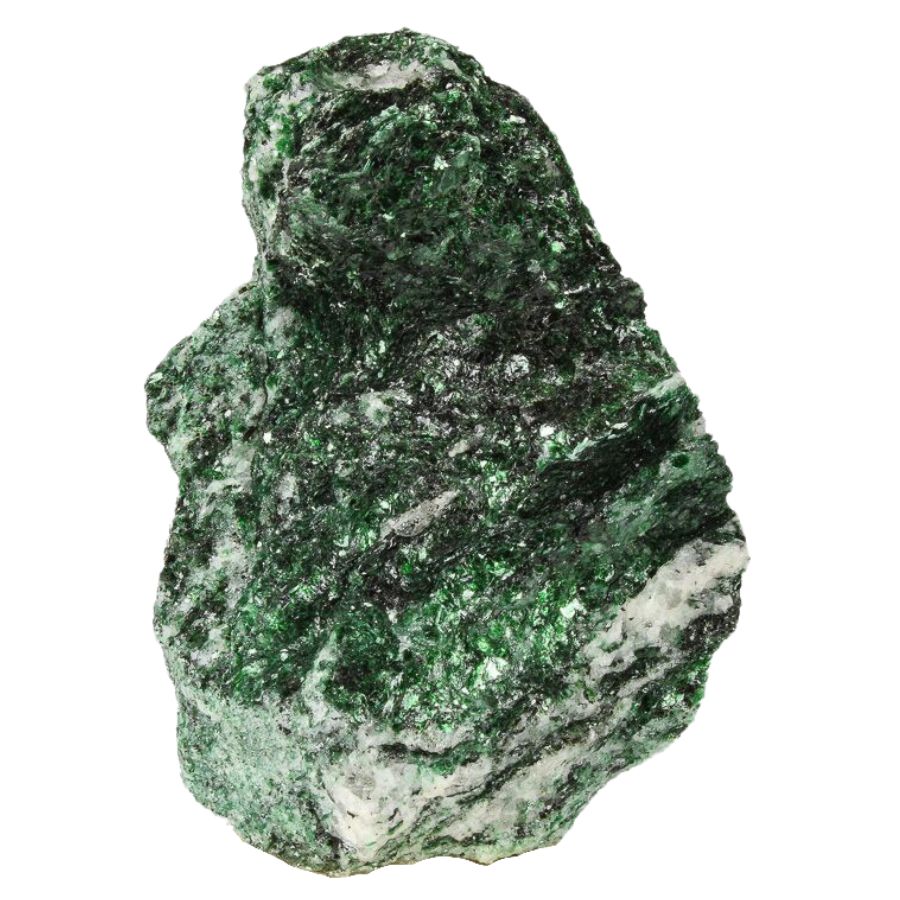
Fuchsite is a green mineral known for its shimmering, sparkly appearance that comes from tiny bits of mica in it. This mineral is often used in jewelry, where its glittery look really stands out and catches the eye.
Fuchsite’s bright green color and glistening surface make it popular for decorative purposes, like in inlays or as part of mosaic art pieces. Some artists use fuchsite flakes in paintings to add a bit of sparkle and depth to their artwork.
Besides its use in crafts, it’s also a hit with rock collectors who love its unique color and texture.
Fun Fact
Fuchsite is actually a type of green mica, and its sparkle is due to the high chromium content, which gives it a bright green color.
It's sometimes called the "healer's stone" because of how the sparkling light reflects, creating a glistening effect that has been admired for years in various decorative pieces.
Where fuchsite is found
Fuchsite is primarily found in Brazil, which is known for its vibrant and quality deposits. It can also be found in parts of India, Russia, and Zimbabwe, among other countries.
How you can identify fuchsite
Color
Fuchsite is characterized by its lovely green color, ranging from a light, minty hue to a rich, emerald shade, all thanks to the chromium content in its structure.
This mineral’s color, combined with its sparkling mica inclusions, gives it a radiant and eye-catching appearance that’s highly valued in decorative pieces.
Hardness
Fuchsite has a hardness of 2 to 3 on the Mohs scale, indicating it is quite soft and can be easily scratched or flaked.
This softness means it must be handled gently, especially when used in jewelry or other decorative items to maintain its beautiful, glittery appearance.
Clarity
Fuchsite typically exhibits a translucent to opaque clarity, with its fine, sparkling mica layers contributing to a slightly cloudy but luminous appearance.
Refractive index
Fuchsite, being a variety of muscovite mica, has a refractive index typically ranging from about 1.56 to 1.59.
Specific gravity
The specific gravity of fuchsite ranges from about 2.78 to 2.91, which is typical for the mica minerals.
Chrome Diopside – Ca(Mg,Cr)Si2O6
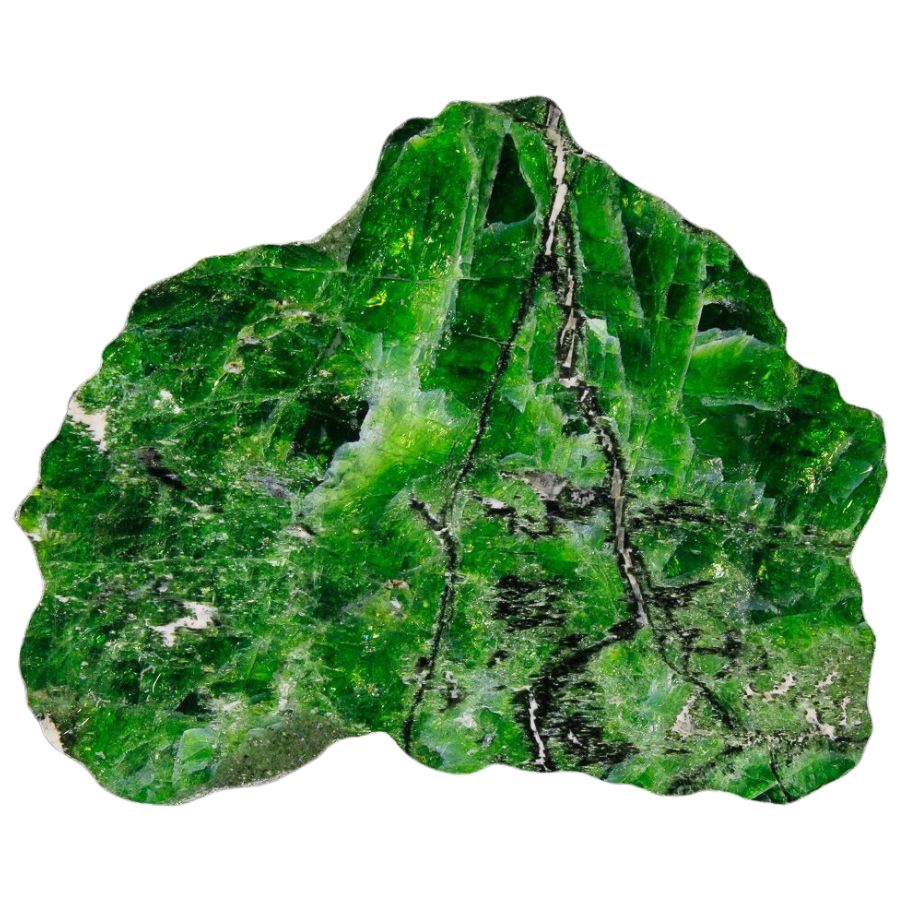
Chrome diopside is a rich green gemstone that catches the eye with its vivid color. It’s often used in jewelry like rings, necklaces, and earrings to add a splash of green.
Due to its color, it’s sometimes chosen as an affordable alternative to more expensive green gemstones. In addition to jewelry, chrome diopside can be used in carving decorative items or as part of a gemstone collection.
Its deep green color is also used in the design industry to provide inspiration for fashion and interior design.
Despite its beauty, chrome diopside is relatively soft compared to some other gemstones, so it needs careful handling to keep it looking great.
Fun Fact
Chrome diopside is often referred to as the "Russian emerald" due to its striking similarity in color and saturation to the precious gemstone.Where chrome diopside is found
Chrome diopside can be found in many places, including Russia, Canada, Finland, India, and South Africa.
How you can identify chrome diopside
Color
Chrome diopside is an intense, vibrant green gemstone with a depth of color that ranges from deep forest green to a lighter grassy hue.
The stone has a high chromium content which gives it its distinctive appearance and creates an almost electric glow.
Hardness
Chrome diopside is considered a relatively hard gemstone, with a hardness rating of 5.5-6 on the Mohs scale. This makes it suitable for use in jewelry, as it can resist scratching and other surface damage.
However, the stone is still quite brittle, and care should be taken when handling or wearing chrome diopside jewelry to avoid any potential chips or fractures.
Clarity
Chrome diopside typically has good clarity, with the most valued stones being nearly transparent and free of visible inclusions.
However, like many gemstones, it can vary, with some pieces having internal features that can affect transparency and overall appearance.
Refractive index
Chrome diopside has a refractive index of 1.676, which is higher than that of quartz and feldspar but lower than that of beryl, spinel, and corundum.
It’s strongly birefringent and pleochroic, meaning it will appear to have different colors when viewed from different angles.
Specific gravity
The specific gravity of chrome diopside is 3.3 to 3.4, considered a moderately high specific gravity for gemstones. This means that chrome diopside is heavier than other gemstones of similar size but lighter than gems with higher specific gravities.
Green Minerals
We’ve got a pretty excellent selection of some of the most brilliant green minerals you can find:
Actinolite – Ca2(Mg4.5-2.5Fe0.5-2.5)Si8O22(OH)2
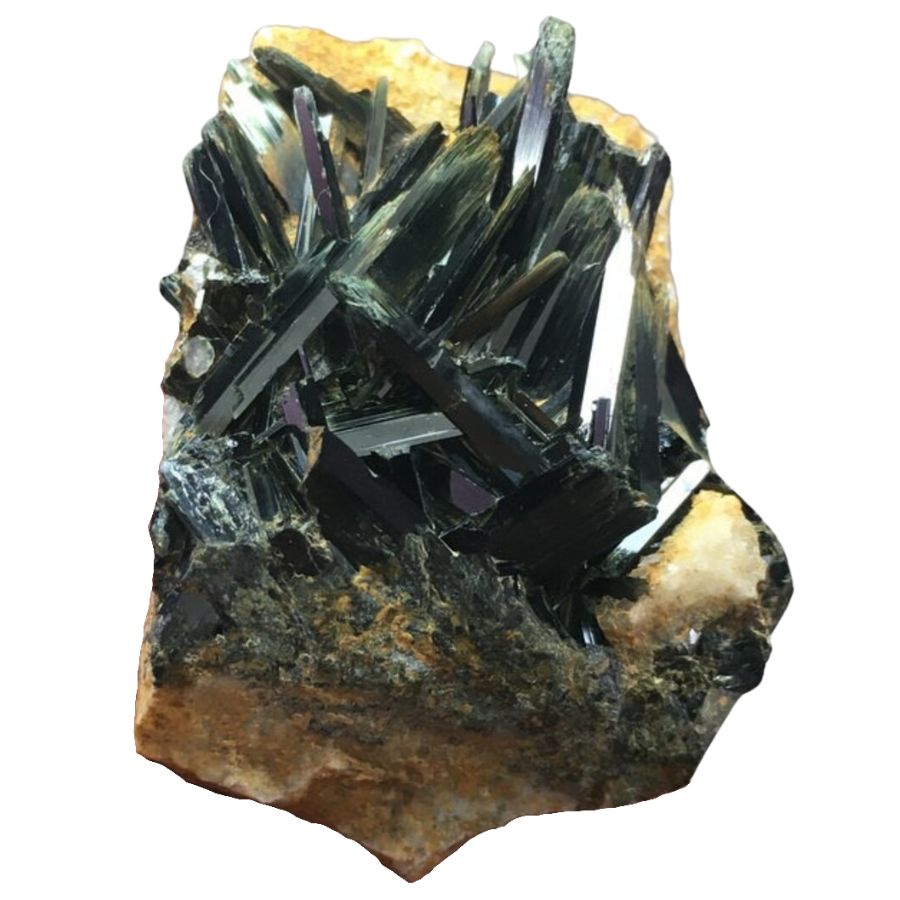
Actinolite is a green to grayish-green mineral that is part of the amphibole group. It’s often seen in metamorphic rocks and can be found in long, slender crystals or fibrous forms.
This mineral is sometimes used in jewelry as cabochons or beads, especially when it’s in its more transparent form. Actinolite is also used in educational settings as an example of amphibole minerals for students studying geology.
Its fibrous variety, known as nephrite, is one of the two types of jade, which is highly valued in carving and jewelry.
While not as commonly used as some other minerals, actinolite is appreciated for its unique color and crystal forms by collectors and gem enthusiasts.
Fun Fact
Actinolite is a type of mineral that is one of the most common forms of asbestos. It's also one of the most dangerous and hazardous forms, as it can cause serious respiratory illnesses if inhaled in large amounts. Be careful!Where actinolite is found
Actinolite can be found in metamorphic rocks, such as gneiss, schist, and phyllite. It’s also found in igneous rocks like diorite and granite, as well as sedimentary rocks such as limestone and shale.
How you can identify actinolite
Color
Actinolite is a greenish-gray mineral, ranging from a light yellow-green to a deep forest green. It can also have shades of blue or brown and may appear almost black in some cases.
The color of actinolite depends on the amount of iron present; the more iron, the darker the color.
Hardness
Actinolite is a relatively soft mineral with a Mohs hardness of 5 to 6. It can be easily scratched with a knife, but it’s still harder than many other minerals.
Its hardness depends on the direction of the cleavage due to its fibrous nature, and it can also be scratched by quartz.
Clarity
Actinolite varies in clarity from translucent to opaque, depending on its form and the presence of impurities or inclusions.
The more transparent varieties are often used in jewelry, while the opaque forms are typically appreciated in mineral collections for their rich color and crystal structure.
Refractive index
Actinolite has a refractive index of 1.622 to 1.628, slightly higher than quartz’s average index (1.544-1.553). This is due to its higher birefringence, which is the difference between ordinary and extraordinary refractive indices.
It has a high dispersion, meaning that it disperses light into its component colors more than quartz, and exhibits strong pleochroism, appearing green or gray when viewed from different angles.
Specific gravity
The specific gravity of actinolite ranges from 2.65 to 3.2, with an average of around 2.9. It’s considered a relatively heavy mineral, having a greater density than quartz and feldspar but less than hematite or magnetite.
Adamite – Zn2(AsO4)(OH)
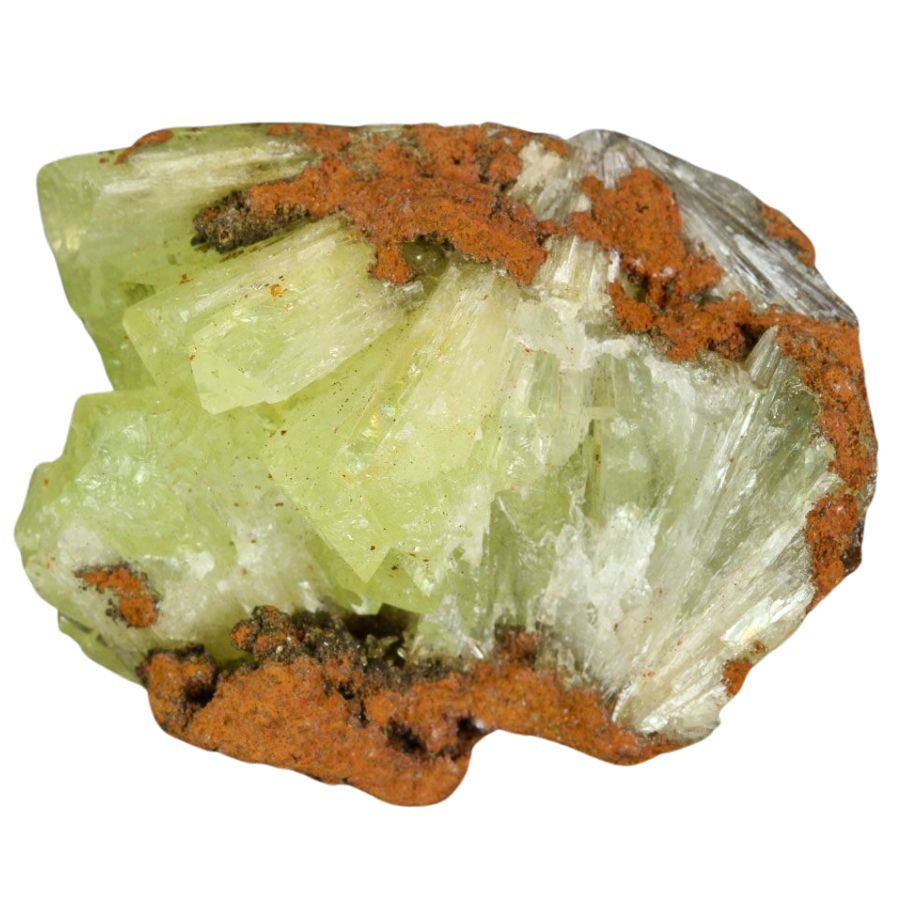
Adamite is a mineral that comes in a range of colors from yellow to green and even blue. It often forms in small, sparkly crystals that catch the light and make it look really pretty.
This mineral is mainly collected by those who love rocks and minerals because of its beautiful colors and crystal shapes. Sometimes, adamite is used in jewelry, but it’s quite a soft mineral, so it needs to be treated carefully.
In science, it helps geologists understand the conditions where it forms, like in ore deposits. People who study minerals, known as mineralogists, find adamite fascinating because of its unique properties and the way it helps tell the story of the Earth’s crust.
Fun Fact
Adamite is a rare mineral that fluoresces under ultraviolet light, giving it a bright green glow.Where adamite is found
Adamites are commonly found in Spain, Mexico, Australia, and South Africa. They have also been found in Brazil, India, and Madagascar.
How you can identify adamite
Color
Adamite is a vibrant yellow-green to greenish yellow mineral with a vitreous luster, often having bright and attractive colors. It can also appear in shades of white, gray, brown, and orange. Its unique color combination makes it stand out among other minerals.
Hardness
Adamite is a fairly soft mineral with a Mohs hardness of 3 to 4. It can easily be scratched with a fingernail and knife blade. It’s not suitable for use in jewelry as it’s too soft to stand up to everyday wear and tear.
Clarity
Adamite typically exhibits a translucent to transparent clarity, allowing some light to pass through and highlighting its bright, vibrant colors.
The clearness of adamite can vary, with some specimens showcasing better transparency and fewer inclusions, making those pieces particularly attractive to collectors and enthusiasts.
Refractive index
The refractive index of chambersite is 1.567 to 1.723, with a birefringence of 0.156, meaning it will bend and split light rays into two when passing through the stone.
The dispersion is 0.016, meaning it will separate white light into its component colors when passed through the stone. Chambersite has a low surface relief and is not considered optically active.
Specific gravity
Adamite has a refractive index of 1.735 to 1.772, which is considered relatively high. This means that light will travel slower when passing through the adamite crystal than other materials, resulting in light being bent as it passes through the crystal.
Datolite – CaB(SiO4)(OH)
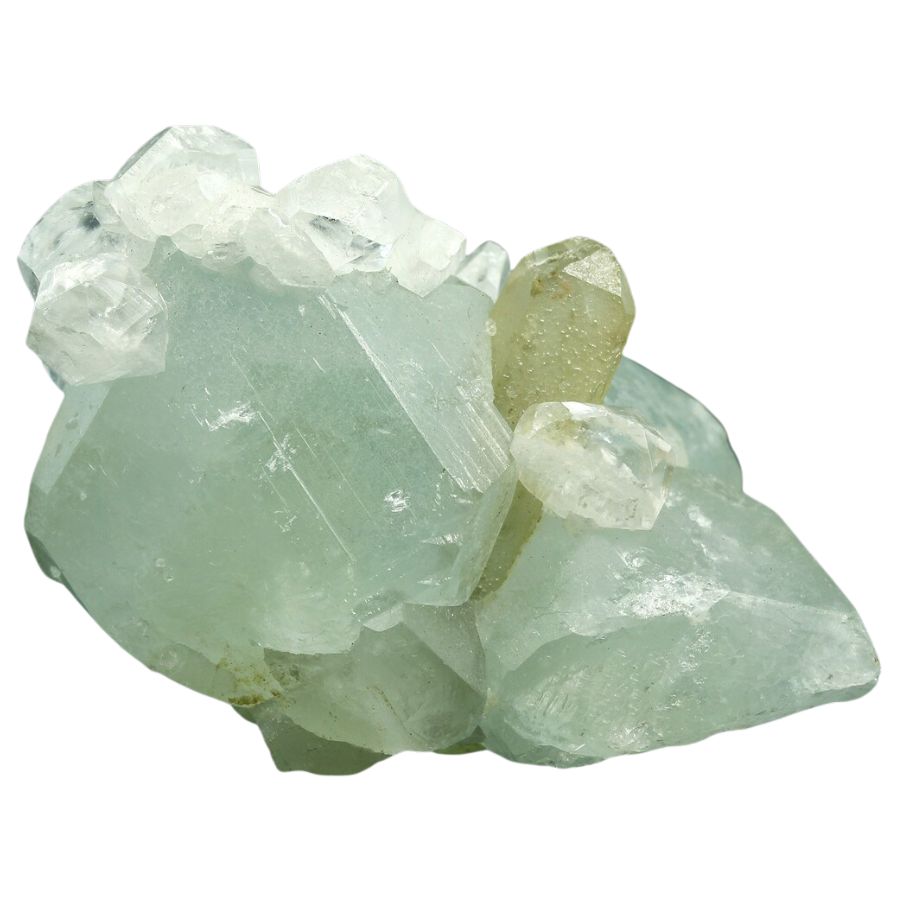
Datolite is a unique mineral that forms in various colors like white, yellow, and green. It’s known for its shiny glass-like appearance and is often cut into gems for collectors who love its look.
People use datolite in jewelry, such as pendants and earrings, because of its interesting colors and the way it catches the light.
It’s also a favorite among mineral collectors who enjoy its crystal shapes and the challenge of finding good specimens.
In larger forms, datolite can be carved into beautiful objects or used as an ornamental stone in various crafts.
Fun Fact
Datolites are believed to be one of the oldest minerals on Earth, estimated to have formed around 2.5 billion years ago. That's almost half the age of Earth!Where datolite is found
Datolites are typically found in sedimentary and metamorphic rocks, such as limestone, shale, and sandstone. They are also found in hydrothermal veins and contact metamorphic zones. Datolites are found worldwide, including in the United States, Canada, Mexico, Russia, Europe, Africa, and Asia.
How you can identify datolite
Color
Datolite is a mineral that ranges in color from pale yellowish green to a deep emerald green. It has an almost glassy luster and is sometimes translucent. It may also contain dark inclusions, giving it a unique speckled or spotted appearance.
Hardness
Datolite is a relatively hard mineral, with a Mohs hardness of 5 to 5.5. This means that it can be scratched by a knife but will not easily break when exposed to pressure.
The hardness of datolite allows it to be used in jewelry and decorative carvings, as the material will not readily chip or wear away over time.
Clarity
Datolite typically has good clarity, ranging from translucent to transparent, allowing light to showcase its glassy luster and color.
This clarity, along with its vitreous shine, makes datolite particularly appealing when cut and polished for jewelry or collected as mineral specimens.
Refractive index
Datolite has an average refractive index of 1.61 to 1.63, considered a moderately high-index mineral. It also exhibits a birefringence of 0.015 to 0.020, meaning it has a different refractive index when viewed from different angles.
The pleochroism of datolite is usually weak and typically ranges from pale green to yellow-brown or colorless.
Specific gravity
Datolite has a specific gravity of 2.9 to 3.2, which is relatively heavy compared to other minerals. This means that it will sink in water and is heavier than quartz, feldspar, and calcite, which all have specific gravities of 2.65 or lower.
It’s also heavier than most other common minerals, making it easily distinguishable from them when found as a mineral specimen.
Epidote – (CaCa)(AlAlFe3+)O[Si2O7][SiO4](OH)
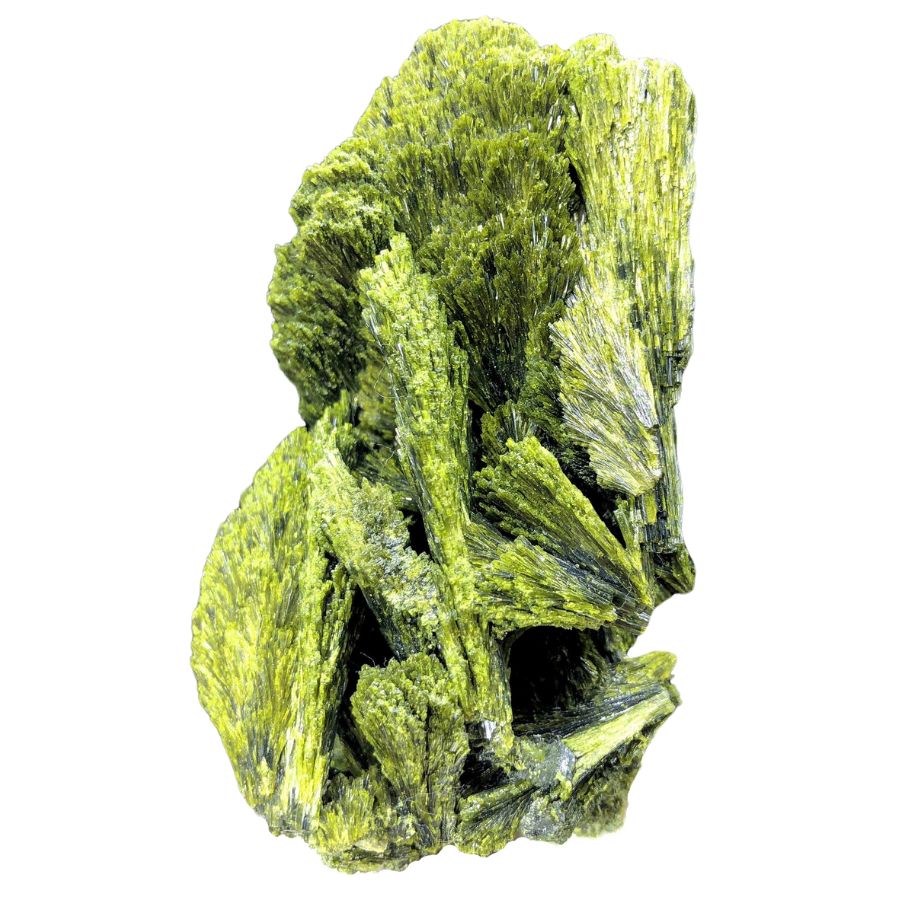
Epidote is a common mineral known for its green color, which can range from a yellowish-green to a deep pistachio. It’s often found in rocks that have been changed by heat and pressure, known as metamorphic rocks.
People use epidote for carving and creating decorative items because of its unique color and the way it polishes up nicely. In the classroom, epidote helps students learn about minerals and the different environments they can form in.
It’s not usually used in mainstream jewelry due to its abundance and typical formation, but it’s prized by collectors who appreciate its distinct, elongated crystals.
Fun Fact
The name is a combination of the Greek words "epi" for "over" and "didonai" for "to give," which essentially translates to "increase."Where epidote is found
Epidote can be found in many places, including the United States, Canada, Mexico, Brazil, Germany, Norway, Italy, Russia, and China. It’s also found in some meteorites.
How you can identify epidote
Color
Epidote is a mineral with a distinct green color, ranging from olive green to dark green. It can also appear yellowish-green or grayish-green in a certain light and sometimes have brown or black hints.
Epidote is unique in its color because it often contains inclusions of other minerals, making the overall hue appear more varied and distinctive.
Hardness
Epidote is a relatively hard mineral, with a Mohs hardness of 6.5 to 7. It’s slightly softer than quartz, but harder than talc and gypsum.
It can be scratched with a knife or steel file, and its hardness makes it suitable for use as a gemstone in jewelry and ornamental carvings.
Clarity
Epidote typically has a translucent to opaque clarity, meaning it allows some light to pass through but not enough to see clearly through the mineral.
Refractive index
Epidote has a refractive index of 1.6 to 2.0, depending on the light’s wavelength. It’s an isotropic mineral, meaning its refractive index is the same in all directions.
This makes it useful for optical components that don’t need to be polarization-sensitive, such as prisms and lenses.
It also has low dispersion, which means it can focus different wavelengths of light in the same place without significant chromatic aberration.
Specific gravity
Epidote has a specific gravity of 3.2 to 3.4, which is relatively high compared to most other minerals. It’s significantly denser than quartz, with an approximate value of 2.6 to 2.7.
This makes epidote particularly useful in mineral identification, as its heavier weight can easily distinguish it compared to other silicate minerals in the same sample.
Malachite – Cu2(CO3)(OH)2
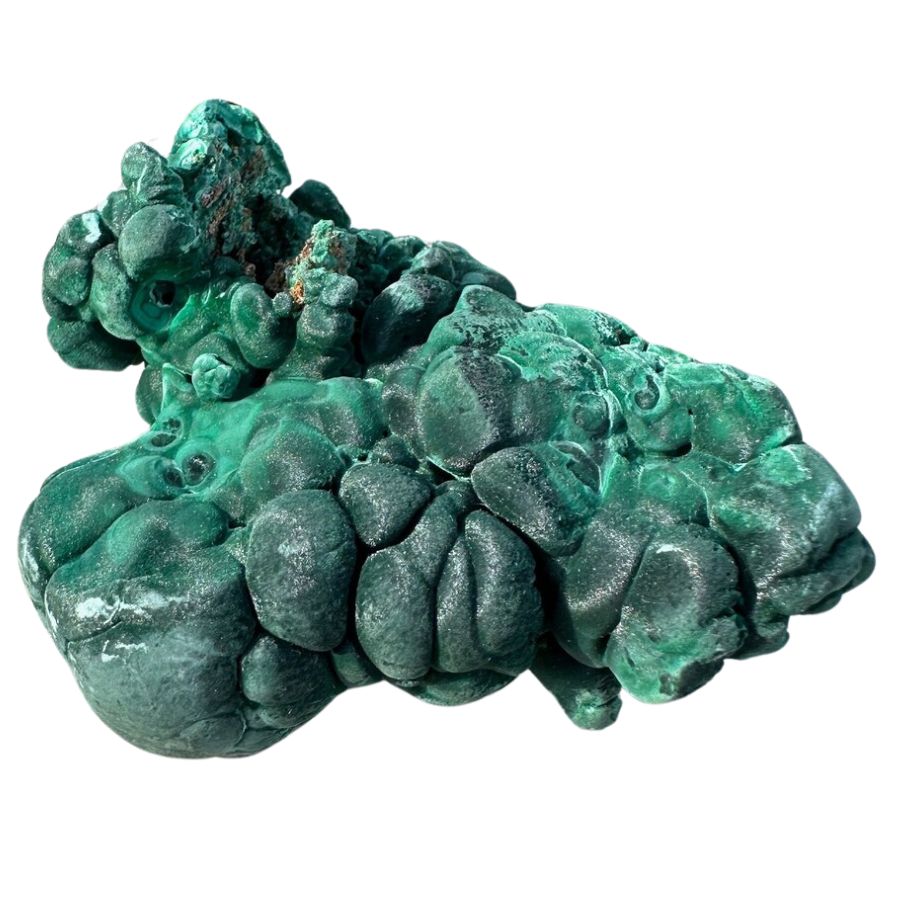
Malachite is a green mineral that’s famous for its bright, vibrant color and unique banded patterns. People often use it in jewelry, like necklaces and bracelets, where its striking appearance really stands out.
It’s also popular for decorative objects and carvings, including bowls, vases, and sculptures, because it can be polished to a beautiful shine.
Malachite’s bold green color has been used historically as a pigment in paints, adding a splash of color to art and decor.
Even though it’s soft compared to other minerals, it’s still a favorite for its beauty and the way it can be shaped into so many different forms. Its distinctive look makes malachite a beloved gem for both personal use and artistic inspiration.
Fun Fact Despite malachite was frequently utilized in sculpting and art, the raw mineral is hazardous. More specifically, its harmful effect comes from copper.
Where malachite is found
Malachite can be found in many countries, including the United States, Canada, Russia, Africa, Australia, and South America. It’s often found in copper-rich areas near mines and natural deposits.
How you can identify malachite
Color
Malachite is a beautiful, deep green color. It’s sometimes described as a mix between green and blue or an intense, vibrant green. The stone has a distinctly banded pattern of light and dark hues ranging from bright emeralds to deep forest greens.
Hardness
Malachite is a relatively soft mineral with a Mohs hardness of 3.5 to 4. It’s not as hard as the quartz varieties but harder than talc and gypsum. It can be scratched with a fingernail, but it can also be polished to a beautiful shine.
Malachite has a unique green color, making it popular for jewelry and other decorative items.
Clarity
Malachite has a vitreous luster, which means it has a glassy, glossy appearance. It’s translucent to opaque and has an interesting banded pattern that creates an almost hypnotic effect when it catches the light.
Refractive index
Malachite has a refractive index of 1.66 to 1.81, higher than most other minerals. This means that light will be bent more when it passes through malachite than through different substances
Because of this, malachite appears to have a greater sparkle and brilliance when cut and polished. It also has a birefringence of 0.15, which is relatively high compared to other minerals and contributes to its unique optical properties.
Specific gravity
Malachite has a specific gravity of 3.7 to 4.1, which is considered relatively high compared to other minerals.
It’s a very dense mineral due to its molecular structure, with a high proportion of heavy elements such as copper and sulfur in its chemical composition.
Chrysoprase – SiO2
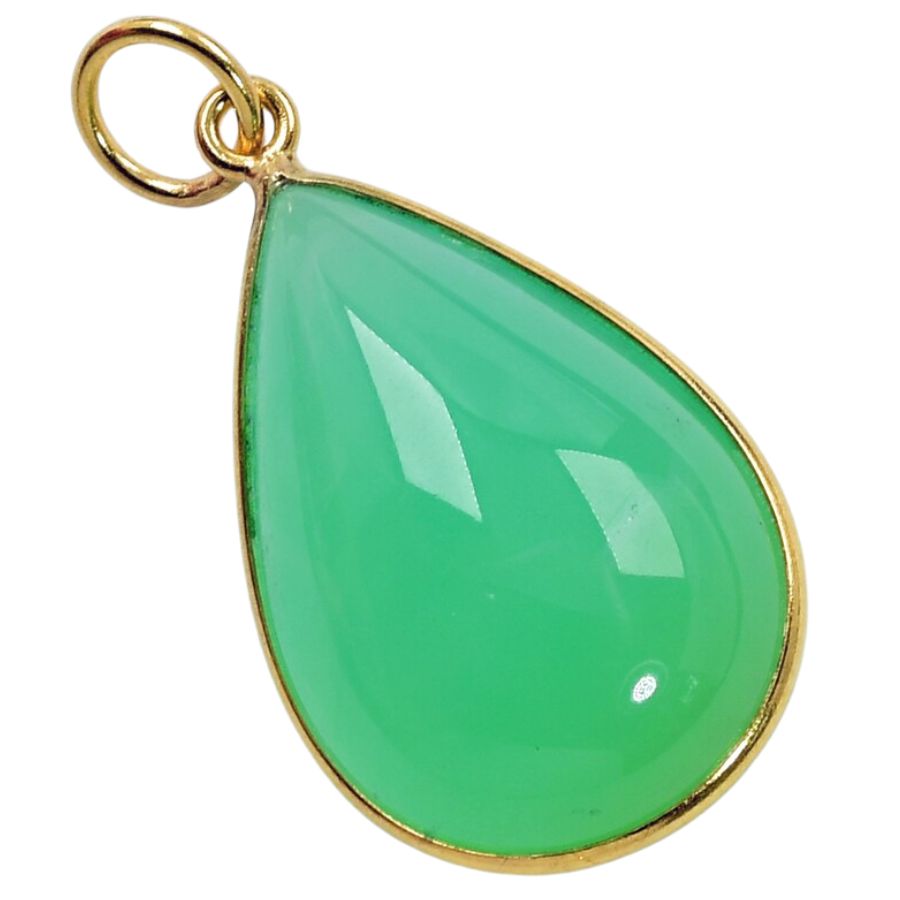
Chrysoprase is a lovely green stone that’s part of the chalcedony family, known for its bright apple-green color. It’s often used in jewelry, such as rings, bracelets, and necklaces, bringing a pop of vibrant color to any outfit.
This stone is particularly favored for its unique shade of green, which stands out among other gemstones. Besides jewelry, chrysoprase is sometimes used in decorative items and small sculptures, adding a natural beauty to various crafts.
People who like collecting rocks and minerals often look for chrysoprase because of its color and the smooth, polished look it can have.
While it’s a favorite for many due to its color, its relatively good durability also makes it suitable for everyday wear, keeping it popular in various forms of accessories.
Fun Fact
Chrysoprase gets its striking green color from traces of nickel in its structure, making it unique among the chalcedony minerals.
Over time, if exposed to too much sunlight, the color of chrysoprase can fade, which is why it's important to store this gemstone properly to keep its vibrant hue.
Where chrysoprase is found
Chrysoprase is mainly found in Australia, which has some of the highest quality deposits, but it can also be found in places like Brazil, Russia, and the United States.
How you can identify chrysoprase
Color
Chrysoprase is renowned for its distinctive apple-green color, which can range from a bright, vivid shade to a more subdued, pastel hue.
Hardness
Chrysoprase has a hardness of about 7 on the Mohs scale, making it relatively durable and resistant to scratches.
This hardness contributes to its suitability for various types of jewelry and decorative items, as it can withstand wear and maintain its polish over time.
Clarity
Chrysoprase typically exhibits a translucency to opaque clarity, with the most prized pieces having a uniform and nearly opaque appearance that enhances their color.
Refractive index
Chrysoprase has a refractive index in the range of approximately 1.54 to 1.55, typical of quartz minerals. This refractive index contributes to the stone’s lustrous appearance and the way it interacts with light.
Specific gravity
The specific gravity of chrysoprase typically ranges around 2.6, consistent with other varieties of chalcedony quartz.
Prehnite – Ca2Al2Si3O10(OH)2
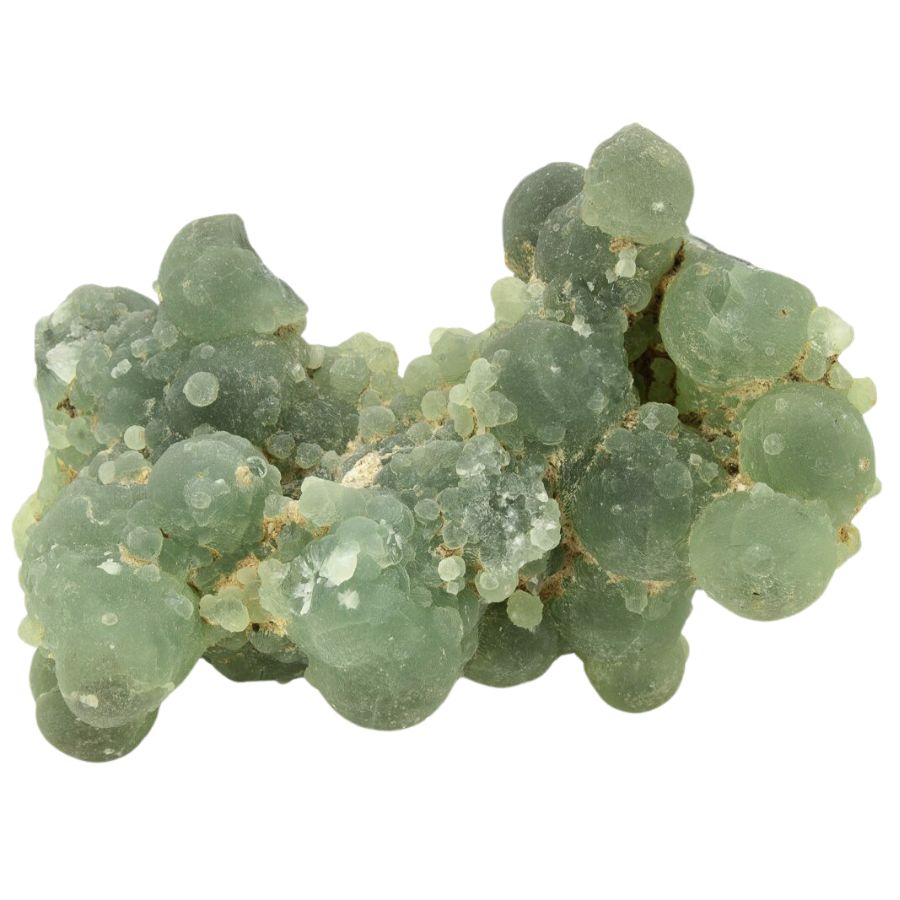
Prehnite is a gemstone that’s usually a soft green or yellow color and is known for its beautiful, calming shades. It’s often used in jewelry like necklaces and bracelets, where its gentle hues can be appreciated up close.
Collectors also like prehnite for its unique crystal formations and inclusion patterns, which make each piece distinct. Its smooth, waxy luster makes it pleasant to look at and hold, adding to its appeal as a stone for both personal adornment and display.
In addition to being worn, it’s sometimes used in carvings or decorative objects, bringing a bit of nature’s beauty into homes.
Fun Fact
Prehnite was named after Colonel Hendrik Von Prehn, who discovered it in the Cape Province of South Africa.Where prehnite is found
Canada, Scotland, India, South Africa, Australia, and the United States are some places you can find Prehnites.
How you can identify prehnite
Color
Prehnite is a pale to bright yellow-green, often with a hint of gray or white. It has a transparent to translucent appearance, and its hue ranges from light yellow-green to vivid lime green.
Its color is often reminiscent of the first hints of spring foliage and new grass shoots.
Hardness
Prehnite is considered a relatively soft mineral, with a Mohs hardness of 6-6.5. It can be easily scratched with a pocket knife or other everyday household items and will show signs of wear when used in jewelry or other applications.
Prehnite is also sensitive to acid and pressure, so care should be taken when handling it.
Clarity
Prehnite typically has a translucent to opaque clarity, allowing some light to pass through and highlighting its delicate color and structure.
While some prehnite can show more transparency, most pieces have a characteristic cloudy or milky appearance.
Refractive index
Prehnite has an average refractive index of 1.65 to 1.69, depending on the angle of incidence and wavelength of the light being measured.
It’s biaxial positive with a birefringence of 0.04. Its optic axis is perpendicular to the c-axis and has low dispersion, showing little variation in its refractive index across visible wavelengths.
Specific gravity
Prehnite has a specific gravity of 2.8 to 3.2, which is relatively low compared to other minerals. It’s slightly heavier than average for non-metallic minerals and about the same as for all minerals.
This low specific gravity makes prehnite easy to identify when searching for it in gravel or soil, as it will be slightly heavier than other elements in the sample.
Smithsonite – ZnCO3
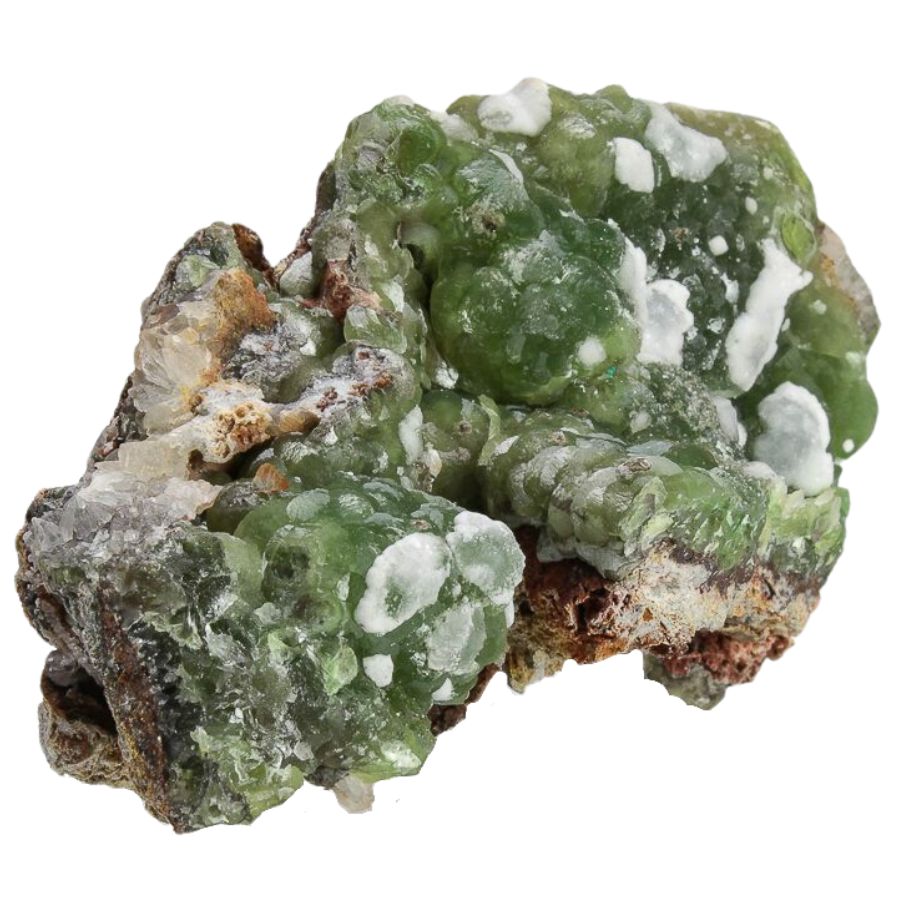
Smithsonite is a mineral that comes in many soft colors, like blue, green, pink, and sometimes even yellow. It’s often used in jewelry because of its gentle, appealing colors and the way it polishes up to a bright shine.
This mineral is also a favorite among collectors who appreciate the variety of colors and smooth, rounded forms it can take. In the past, smithsonite was used in the production of zinc, playing an important role in industry.
Today, it’s mostly appreciated for its beauty and is commonly found in decorative items, adding a touch of color and elegance. Its subtle luster and variety of colors make smithsonite a versatile and attractive mineral for various uses and collections.
Fun Fact
Smithsonite was named after James Smithson, the founder of the Smithsonian Institution.Where smithsonite is found
Smithsonites can be found in various locations, including the United States, Mexico, Australia, and Canada. They are commonly found in zinc ore deposits.
How you can identify smithsonite
Color
Smithsonite is a mineral found in various colors, ranging from white to yellow, pink, orange, green, and blue. Its most common shades are greenish-blue or light blue.
Hardness
Smithsonite is a fairly soft mineral, with a Mohs hardness of between 3.5 and 4. It’s quite easy to scratch with a knife and can be ground down with sandpaper.
The softness of the mineral means it can be easily worked into jewelry or other decorative pieces, but it’s not suitable for use in tools or weapons.
Clarity
Smithsonite, a zinc carbonate mineral, is renowned for its exceptional clarity, often displaying a glass-like transparency that enhances its aesthetic appeal.
This crystalline mineral can exhibit a range of colors, but its clarity remains a standout feature, making it a sought-after specimen for collectors and gem enthusiasts.
Refractive index
Smithsonite is a carbonate mineral composed of zinc carbonate and typically has a refractive index of 1.7 to 1.8, which is considered relatively low compared to other minerals.
Its birefringence is also low at 0.005 to 0.007, meaning that the mineral appears to have no color change or pleochroism when viewed from different angles.
Specific gravity
Smithsonite has a specific gravity of 5.0 to 5.3, which is relatively high for common minerals. This makes it slightly heavier than average compared to other minerals and rocks and indicates its high zinc content.
Variscite – AlPO4 · 2H2O
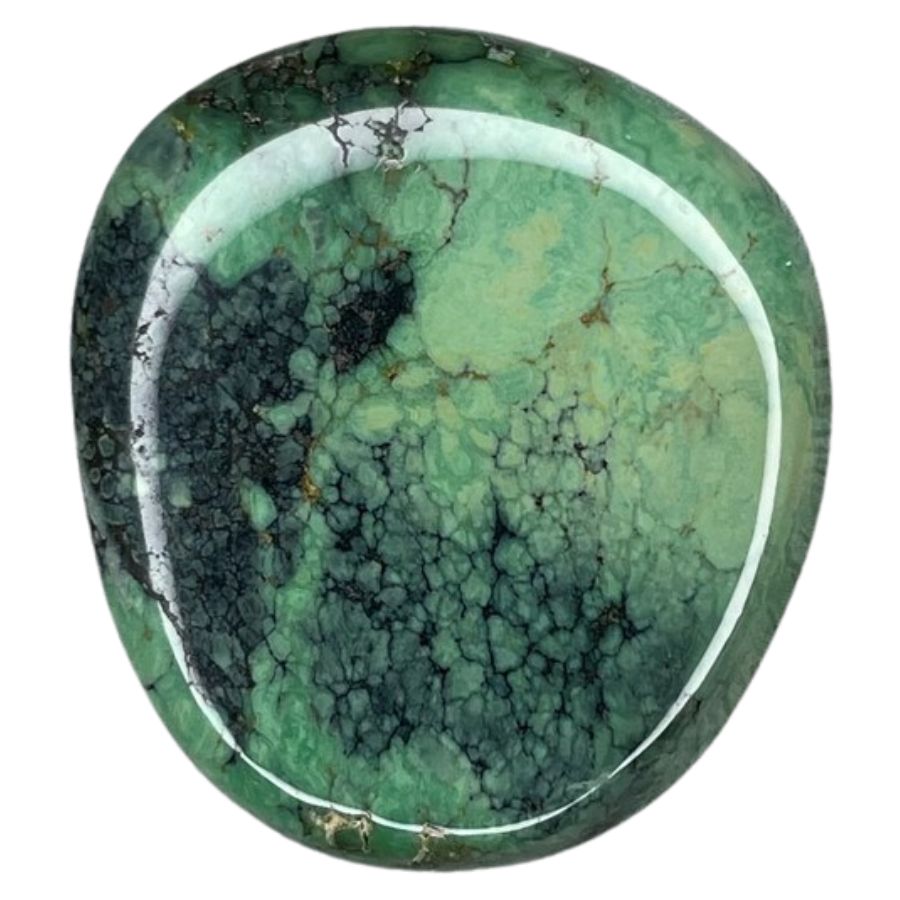
Variscite is a cool mineral known for its vivid green color, which makes it popular in jewelry like necklaces and earrings. This stone is often shaped and polished to bring out its natural beauty.
People also use variscite in small carvings and decorative items, adding a splash of color to different things. It has a calming green hue, similar to the color of leaves in spring.
Variscite isn’t just pretty; it’s also durable enough to be used in various crafts. This makes it a favorite among those who enjoy creating unique and colorful pieces.
Fun Fact Due to variscite's porosity, it has a propensity to absorb grease and oil, which taints it.
Where variscite is found
It’s often found in the form of nodules or veins and locations worldwide, such as Utah, Nevada, Australia, Germany, and Poland.
How you can identify variscite
Color
Variscite is a beautiful and unique mineral that ranges from light to dark green and may also contain yellow, blue, and red hues. It often has a mottled or banded appearance with swirls of various colors.
Hardness
Variscite is an opaque to transparent gemstone with a hardness of 5.5 to 6 on the Mohs scale. It’s relatively soft and should be treated with care, as it’s sensitive to scratches and chips.
Variscite is durable enough for everyday wear but should not be exposed to any harsh chemicals or abrasives that may cause damage.
Clarity
Variscite is known for its typically opaque to slightly translucent appearance, which contributes to its unique and striking look. Unlike some other gemstones, its beauty comes from its rich, uniform color rather than from clarity or light reflection.
Refractive index
Variscite is a hydrated phosphate mineral that has a refractive index ranging from 1.60 to 1.64, with an average of 1.62.
Specific gravity
Variscite is a phosphate mineral with an average specific gravity of around 2.9, slightly heavier than most minerals.
Vesuvianite – Ca10(Mg, Fe)2Al4(SiO4)5(Si2O7)2(OH,F)4
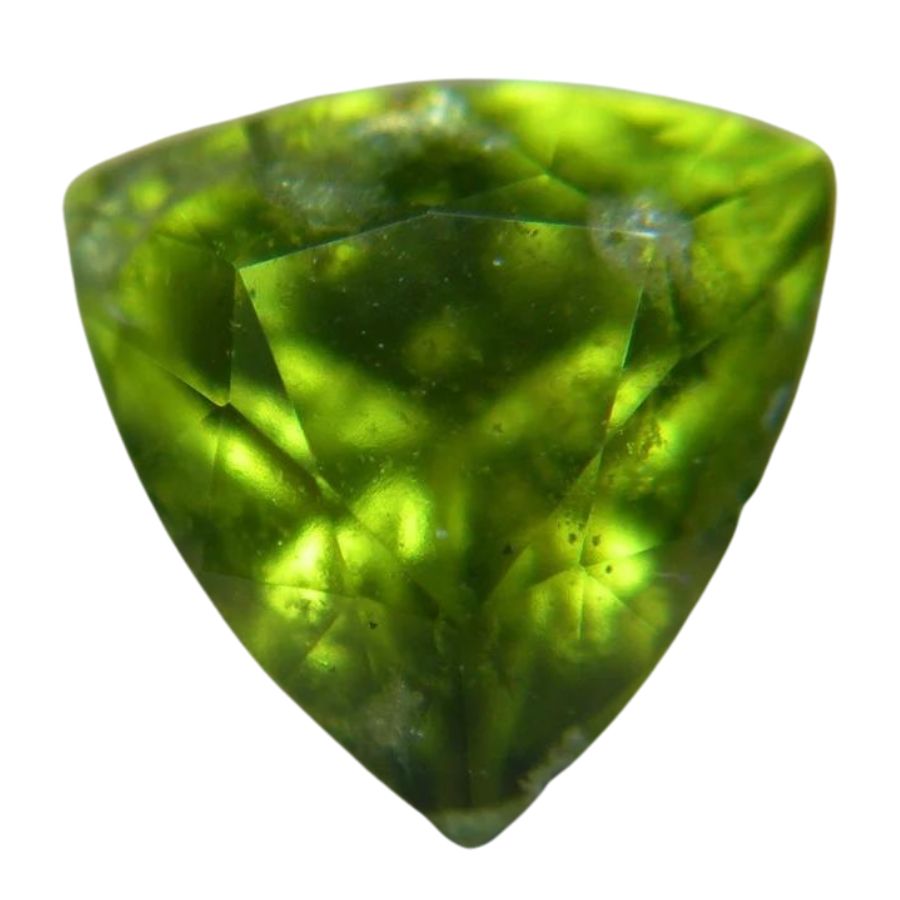
Vesuvianite, a fascinating mineral, comes in a range of colors like green, brown, yellow, and even blue. It’s often used in jewelry, where its different colors make each piece unique and eye-catching.
Besides jewelry, vesuvianite is used in small sculptures and ornamental objects, adding a touch of natural beauty. Its varied colors make it popular for collectors who love colorful and interesting rocks.
Crafters and artists also appreciate vesuvianite for its ability to be shaped and polished, making it versatile for various creative projects.
Fun Fact Don't know what gift to give to newly weds? Due to its associations as a cooperative stone that encourages awareness of one's heart and the capacity to express love, vesuvianite has been given as a wedding present.
Where vesuvianite is found
Vesuvianite can be found in certain locations, including the United States, Canada, Italy, France, Germany, Austria, Switzerland, Norway, and other European countries. It’s also found in India and Sri Lanka.
How you can identify a Vesuvianite
Color
Vesuvianite is a striking and unique mineral, with a color that ranges from deep green to yellow-green, sometimes with brown or olive hues. It can also have an orange-brown or reddish tint.
The intensity of the color varies depending on the light source and angle of view. It can sometimes appear almost black in certain lighting conditions.
Hardness
Vesuvianite is a relatively hard stone, with a hardness rating of 6.5 to 7 on the Mohs scale. This puts it below quartz on the scale, making it harder than glass and softer than topaz.
It’s quite durable and can withstand everyday wear and tear. Its hardness makes it suitable for jewelry, other decorative items, and carving purposes.
Clarity
Vesuvianite typically displays a translucent to opaque quality, contributing to its unique and attractive appearance. This characteristic allows for a depth of color that is particularly admired in jewelry pieces and ornamental designs.
Refractive index
Vesuvianite has a refractive index ranging from 1.649 to 1.665, slightly higher than quartz but slightly lower than beryl. It also has high birefringence.
Specific gravity
Vesuvianite has a specific gravity of between 3.13 and 3.32, depending on the variety of the mineral. It’s a relatively heavy gemstone compared to other minerals, with a density much higher than the average for most gems.

